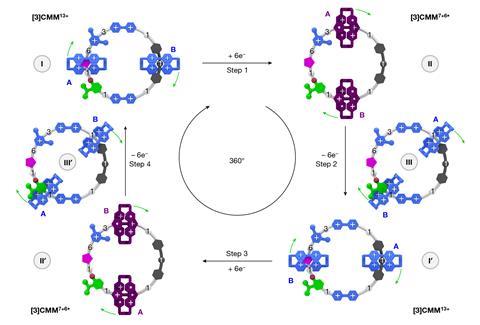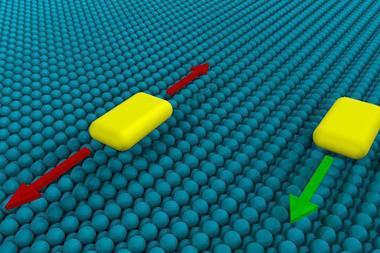A molecular motor that can be powered by electricity has been created.1 In contrast to existing single-molecule electric motors,2,3 the new [3]catenane motor can be operated without a scanning tunnelling microscopy tip. ‘Previous electrically driven motors required high vacuum and elaborated setups to operate,’ comments Giulio Ragazzon from the University of Strasbourg in France, who wasn’t involved in the study. ‘The present system works under mild conditions – an important requirement for further progress.’
‘Our catenane is composed of two small, identical, four positively charged rings and a much larger [50-membered] cyclic loop,’ says Long Zhang at Northwestern University in the US. ‘There are two different states – an oxidised and a reduced state – and by varying the voltage, we can achieve unidirectional, clockwise motion of the two rings around the loop.’ Ragazzon points out that one-way rotation wouldn’t happen spontaneously in this system. ‘Studies like this one are formidable advancements in the ability to control matter at the molecular level,’ he says.
Zhang explains that when the catenane is reduced, the small rings move from the 3 and 9 o’clock positions to the 6 and 12 o’clock positions. But when the system is oxidised, a Coulombic barrier forces the rings to continue moving in the same direction until they’re back at 3 and 9 o’clock.
‘The researchers used a smart trick to prove that unidirectional rotation was taking place,’ explains Ragazzon. ‘They substituted some hydrogen atoms in one ring with deuterium, which allowed them to distinguish between two otherwise identical rings.’

Tibor Kudernac at the University of Groningen, Netherlands, who helped to build one of the first single-molecule electric motors back in 2011, says that the new approach is a ‘very elegant’ way to engineer potential energy surfaces using redox chemistry. ‘What I find so inspiring about this work is that it’s based on the same working principle as these Brownian ratchet mechanisms that are prevalent in biomolecular machines,’ he notes. ‘In addition, the system is powered by electrons, which considerably boosts the speed of the molecular operations and circumvents problems with the continuous delivery of chemical fuel and waste management, two of the most significant obstacles to the sustained functioning of molecular machines.’
‘What we’re doing – as anybody working in the molecular motor field with either chemicals or electricity – is altering the landscape,’ explains Nobel laureate Fraser Stoddart at Northwestern University. ‘It’s all about raising energy wells and lowering transition states. Biomolecular and artificial molecular motors are under the control of these landscapes, which are altered by chemical means. Electricity can be introduced if we use an electrochemical cell, so we’re still doing chemistry, even though we’re using electricity.’
The tiny electric motor contains an asymmetrically designed steric barrier. ‘This asymmetry in combination with the electron-fuelled switching of the optimal binding sites for the two moving rings is sufficient to cause circumrotatory motion of the two rings around the loop,’ says Kudernac. The team first tried to use a [2]catenane to make the machine, but that didn’t work because the process wasn’t asymmetric enough.
Zhang says that the [3]catenane motor was developed based on previous research on molecular pumps and adds that if many electric molecular motors are attached to an electrode surface, they could do useful work transforming electrical into mechanical energy.
Stoddart says that interdisciplinary cooperation has been crucial to the project’s success and notes that the team has put in over four years of hard work. ‘The one thing I often feel that gets lost is the amount of intellectual and experimental effort that has to go into producing something of this nature,’ he says. ‘Demanding projects don’t happen overnight. You need people at all levels who know what they’re doing, which means that they have to be pretty intelligent, highly knowledgeable, incredibly patient and – above all – enormously hard-working.’
References
1 L Zhang et al, Nature, 2022, DOI: 10.1038/s41586-022-05421-6
2 T Kudernac et al, Nature, 2011, 479, 208 (DOI: 10.1038/nature10587)
3 HL Tierney et al, Nat. Nanotechnol., 2011, 6, 625 (DOI: 10.1038/nnano.2011.142)
February 2023 research news

All the research news from across the chemical sciences that we couldn’t fit this month’s print edition
- 1
- 2
- 3
 Currently
reading
Currently
reading
Molecular motor running on electricity mimics biological motors
- 5
- 6
- 7
- 8
- 9




![Chemical structure of Pillar[6]MaxQ](https://www.chemistryworld.com/Pictures/80x50/6/2/1/523621_chempr1747_proof1_891632.jpg)







![Chemical structure of Pillar[6]MaxQ](https://d2cbg94ubxgsnp.cloudfront.net/Pictures/80x50/6/2/1/523621_chempr1747_proof1_891632.jpg)
















1 Reader's comment